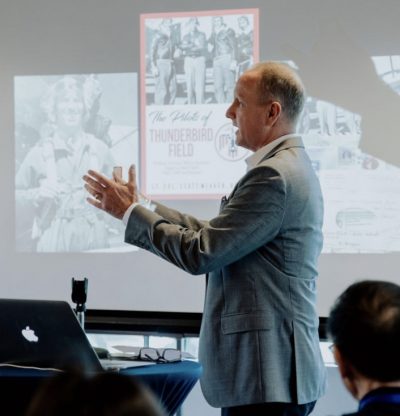Finding Your Passion
By Scott | November 12th, 2018

You often hear people advise others – “find your passion.” What does that really mean? Are they referring to passion at work? Or perhaps passion in a sport or hobby? What exactly are they talking about?
I was fortunate to find passion in flying while in the USAF. But still, at times even this prestigious job was just a JOB. What I was passionate about was competing – competing with others to be good enough to get an assignment to fly the F-16.
When I first went to pilot training, I didn’t really know what type of aircraft or mission I wanted to fly. Back then, everyone started with a group of 60-70 guys, split into two flights. After ground school, each pilot begins by flying the T-37 – learning the basics of “contact” flying. This training included some flight patterns and landing skills, stalls and falls, aerobatics and communication procedures. Later, we learned some formation and instrument procedures. After about 4 ½ months you “moved to the other side of the hallway” to the fast jet or the T-38A.
The T-38A training was great. Our first ride or “Dollar” ride as it was called, was a supersonic ride where you saw the airspeed push through 1.0 mach. Though not really a big deal, it was enough to make us realize we were student pilots.
It was during the formation phase of flight, in the T-38, that I began to realize my potential. Up to that time, I believe I was just an average student – somewhere in the middle of the pack. But it was on a flight with Lt. Curt Crawford, who is now an American Airlines 737 Captain based in Dallas, that I turned the corner in Undergraduate Pilot Training (UPT).
Curt was a “good ole boy” from Texas A & M and had an “ah shucks” manner about him. For me, this flight was just another ride on a long list of syllabus rides that I had to accomplish in order to receive my USAF “silver wings.” The ride was a two-ship formation flight – with me flying solo in my own T-38A. I was the “wingman” on takeoff. Then we proceeded to fly to the western part of Oklahoma in our military restricted airspace or (MOA). Lt. Crawford and his student were in the lead jet. Once in the designated area, we did some standard “pitch out and rejoins” to warm up. This was procedure where the wingman would “peel off” aggressively from the flight leader, with a 3-4 g pull-away for about 5 seconds, to gain about 1-2 miles separation from the opposing jet. Then, the flight lead would do what is called a “wing rock” back and forth and set a 30 degree bank turn either right or left. At that time, the wingman, which in this case was me, would establish a flight path, angle and closure to reduce the distance at a safe pace in order to complete the rejoin. The procedure is a three-dimensional maneuver in space where you methodically place the lead aircraft on the horizon and your aircraft is a “cigarette pack” below. At this point, you place the wing tip of the lead aircraft in the “small of the back” of your own fuselage, to establish the appropriate line. You set your airspeed at 400 knots or so, knowing and trusting your flight lead is at 350 knots.
As you can imagine from the description above, this was a very challenging maneuver for new student pilots. On our second “pitch out and rejoin”, where I was the leader, I hear my flight lead call “BLIND” over our common frequency radio. This meant that both he and the instructor pilot (IP) had lost sight of me. Their two sets of eyes against mine. It happens – and on this occasion – I still had them in sight as we flew in the blue Oklahoma sky.
I immediately instructed them to be “tactical” lead and directed them to set a 30 degree right hand turn at 350 knots. I would reverse the rolls and rejoin them. They still did not have sight of me until I was within 6,000 feet of the rejoin. Once I know they had me in sight, I continued the rejoin until about 500 feet, directed them to roll wings level, and I passed back the tactical lead to them. I then resumed my responsibilities as a wingman.
When we landed, my IP Lt. Crawford complimented me. He couldn’t believe that I was able to display so much “SA” – situational awareness. After dropping off my parachute and helmet in the Life Support room, I found Lt. Crawford in the Flight Commander’s office praising my flight. Little did I know at that time that I was now being groomed to become a First Assignment Instructor Pilot or FAIP. My passion was born.
About Me

Scott Weaver is a public speaker, author, pilot, aviation historian and retired Lt. Col. USAF.